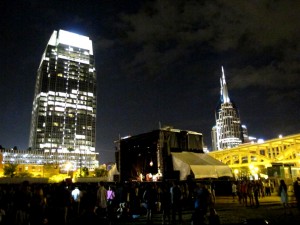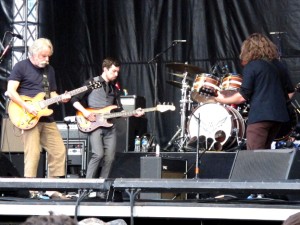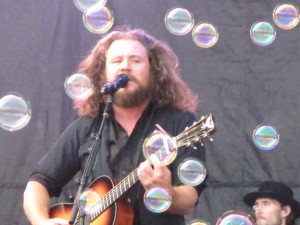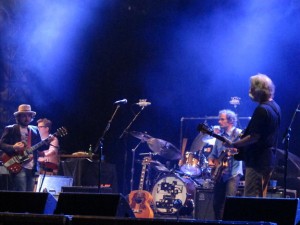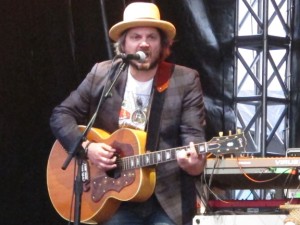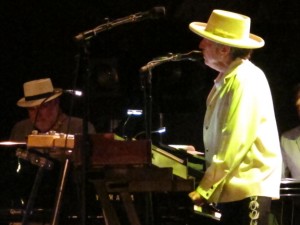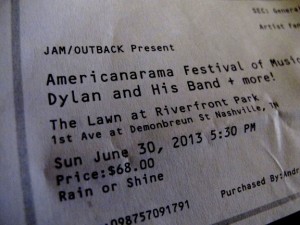My music fandom began sitting on the carpeted floor of a middle-class house in the suburbs of Cleveland, Ohio. My parents owned a record player and a handful of albums, among them The Beatles’ Revolver and The Freewheelin’ Bob Dylan. Much like the scene in Almost Famous when the protagonist’s sister turned her younger brother onto her tunes, the needle touched vinyl, and pretty much everything changed. By junior high, the music of The Beatles and Dylan saturated my psyche and shaped my identity.
At the time, the likes of Simon & Garfunkel, The Rolling Stones, and Led Zeppelin also seared my ears and soothed my soul. Rock ‘n’ roll inspired all-night adolescent airband artistry and class presentations on the poetics of the Don McLean song “American Pie.” Tragedies like the respective deaths of John Bonham and John Lennon jolted our reality. We discovered that Bonham died when we went to school one day and had to ask, “Why are all the burnouts crying?” But of course when Lennon died, everybody cried. Like the McLean song prophesied, we had many, many days when the music died.
In my high school years, punk, new wave, and of course the jubilant jangles of REM and the angelic anthems of U2 put some distance between me and 60s-70s classic rock, but I grew up in close enough proximity to the actual hippies and stoners that I would always suffer an epic kinship to these transformative periods of American popular music that still impact us today.
With all the burning-out and fading-away and ultimate fatality, it’s no short miracle than any of the greats that all but danced down the apocalypse still survive this far into the 21st century, to this post-2012 period of popular musical renaissance and revival. With all this in mind, I feel such gargantuan eardrum-obliterating gratitude in relishing the immediate memories of the fantastic fact that in June 2013, in a span that stretched 16 days between two amazing weekends in Tennessee, I would see Paul McCartney at Bonnaroo and Bob Dylan on the Nashville riverfront. I’m likewise blown-away by some of the other bands we’ve been able to hear, the peers for my ears, who along with the headliners create bookends of beauty and blessing, of soggy singalong eyes and goosebump-inducing bliss.
Frankly, I cannot hype enough hyperbole to express the hopeful holiness, mix enough metaphors to convey the meaning, or raise high too many mocktails to celebrate the recently passed occasions. Frankly, I would feel too selfish to savor this if I didn’t have the chance to suggest you catch Dylan or McCartney who are both still on tour, if the other peers-for-the-ears were not still hitting up festival-after-festival for the rest of the summer. As endless rains fall on my 4th of July holiday weekend, I scribble this testimony in hopes that someone might get a nibble of the goodness I’ve already experienced and perhaps seek out some of these shows the rest of the summer. As I ponder some of the more painful and plainly ludicrous prices that others have paid for the privileges I enjoy, I admit that I am most patriotic when it comes to our popular common culture, from sport to movies, but I am a patriot when it comes to music most particularly.
Since The Beatles official touring ended in 1966 and since Lennon died in 1980, I don’t think I’ve ever really wrapped my mind around the sheer significance of a Paul McCartney tour. Sure, we hear snippets of his later work and lots from the Wings period, but at root, we’re not hearing McCartney cover The Beatles; McCartney is a Beatle. Here in my mid-40s, more than a decade into the new century, I am watching a man in his 70s, looking and sounding sharp and charismatic do nothing shy of reclaiming and reviving with sonic groove and grace the greatness of The Beatles.
We hear love songs that kindle every feeling of passion I have for my partner dancing beside me and our world living and dying around us. We hear a song of letting-go like “Let It Be,” and for those few minutes we actually obey and let go; we let, it, be! Psychedelic moments surge forth from the tunnel of memory into the sober mess of the present, and we get crazy happy hearing “Helter Skelter” or “Being for the Benefit of Mr. Kite!” Throughout McCartney’s set at Bonnaroo, I had several delightful moments where disorientation met déjà vu, and I felt myself wonder, “Is this even happening?” Similar sensibilities of timely and timeless wonder would return in a little over two weeks at the Nashville riverfront.
Most people benefit from an extracurricular passion or hobby or two—or in my case several. As much as I have hoped to enhance and enjoy the avocation of music fandom, at times, I almost abandoned it or even worse sabotaged it. At one point, I almost lost track of the best tracks from sheer necessity and lack of time or lack of money. But then it gets worse, at the very time my fandom had rekindled with verve and passion. Like too many before me and too many after me, I tried to spice up the musical listening and dancing experience with drugs and alcohol. This resulted in bad trips, drunken mistakes, and general stupidity—all in pursuit of a quicker fix and higher high. The Americanarama festival that’s now on tour brings together artists for whom, all at different times, I have an acute recollection of almost wrecking the cosmic connection that their music brings for me.
Spanning the years from 1988 to 2008, from the days of youthful entheogenic experimentation to the seemingly endless nights of excessive intoxication, I occasionally overestimated my abilities and my tolerance and seriously compromised my boundaries and my values. Let’s just say I’d undermined otherwise potentially perfect nights with The Grateful Dead, My Morning Jacket, and Bob Dylan, ruined not so much for anyone else, but trashed for myself. Yet on the last day of June, I had an opportunity for musical redemption, getting high on the songs and on life, on enjoying the modesty and the clarity of not being “that guy” at the show.
Former Dead and current Furthur guitarist Bob Weir performing solo begins the itinerary, and we got to the show early enough to catch his set. In fact, we could hear Weir’s soundcheck as we lined-up outside the venue and were satisfied to get a spot up-close by the stage—even if the ground, instead of a carpet of grass, was merely a fresh layer of mulch, the kind that smells just a little too fragrant, too much like, well, mulch. Other reports have it that the sound quality suffered towards the middle and back of the field, but we were glad to be so close and not need earplugs to enjoy the show.
After opening with a Ratdog track that I enjoyed but didn’t recognize on electric guitar, Weir followed on the acoustic with the Dead standards “Loose Lucy” and “Friend of the Devil.” The pearls of rock wisdom that lit up his lips and fell from Weir’s lyrics were simple yet prophetic and paradoxical in the opening song: “If we don’t believe together, we might just cease to be”; and the final refrain “Dreams are lies, it’s the dreaming that’s real.” Of course this rings authentic to me, for whom the drunken dream was a lie, but dreaming a sober psychedelic experience suddenly became real!
My rekindled Dead interest has increased over the last few years as I have rediscovered their music without the aid of any of my former chemical crutches. Music that I once presumed required a listener to be intoxicated has opened itself up to me in new and magical ways completely clean. Last summer, I missed a Furthur show that I’d planned for—in order to attend a funeral; I still have hopes to catch one before too long. I cannot help but admitting that learning Bob Weir would be part of this AmericanaramA event felt like some beatific cosmic payback for doing the right thing last year.
After covering the Bob Dylan track “Most of the Time,” mentioning that we wouldn’t hear it later, Weir closed his too short set with a track he co-wrote called “Cassidy.” The lines invoke endless youth: “Ah, child of countless trees. Ah, child of boundless seas.” The stories behind the song are both a charge of hope for a young child born to the Dead tribe back-in-the-day and a tribute to the late Neal Cassady, the reckless and impetuous idol of Ginsberg, Kerouac, and the Beat Generation. The old me was like Neal Cassady, one who sought a false boundlessness of hedonistic debauchery, but the new me might be more like a reborn child who sees countless blessings in a sea of hopeful faith and fidelity, an inner freedom to which the many wildly-winding and rocky-rocking roads finally led me.
I must say that the time between sets at shows can grind down my serenity and patience. Whether out at the food lines and bathroom lines or standing or sitting simply waiting, the minutes that usually fly by just drag on. This time we brought a deck of cards to pass the time as we sat on our now mulch-soiled blanket. But we could barely finish one hand of rummy before My Morning Jacket stormed the stage to open with a campfire anthem that more often closes a show, “Wonderful (The Way I Feel).” The ensuing 75 minutes flew by, with many of our absolute favorite Jacket songs and some surprise back-catalog nuggets. The whole band was tight, animated, on. Something about seeing them in daylight from so close to the stage, especially before the people around us were totally trashed and pushing past us, made this a perfect set for me.
In the midst of all this gloriousness, Bob Weir joined the group on stage to perform two Dead numbers. The first song they chose was “Brown Eyed Women,” the lyrics for which I could not get out of my head for days following the show, and these filled me with wicked irony. Here I am cold sober singing in my head the sloppy refrain, “Brown eyed women and red grenadine/the bottle was dusty but the liquor was clean.”
It’s a great comfort to me that another Dead song called “Wharf Rat” is about a down-and-out drunk and that this tag has become the moniker for the Wharf Rats, the seminal clean-and-sober fan community that’s created a far-flung fellowship and meeting support structure for Deadheads who voluntarily abstain from alcohol or drugs.
All this said, the Grateful Jacket ranks as one of my greatest concert experiences ever, just those two songs, almost like it was destined to happen since before our MMJ boys were even born. During some of the jammier moments, the way the rest of the Jacket members focused their attentions and intuitions on Weir was just mindblowing. The almost acapella harmonies at the end of “I Know You Rider” with Bob, Carl, and Jim singing to the center of my gut, that was so phenomenal that I just want to cry thinking I actually got to see it! Ever since I first heard it some 25 years ago, the line towards the end of the song—“I wish I was a headlight on a northbound train”—has conveyed such hope for me; others have been that light for me, and we can be that light for others.
At this point, AmericanaramA could be called AmericanaJamma if you ask me. Smiling, I went from “wow” to just more—wow wow wow! The collaborative synchronicity and spontaneity continued during the Wilco set when Weir returned for two more songs, first the Dead’s “Bird Song” followed by a face-melting and sheer shredding rendition of “Tomorrow Never Knows” by the Beatles. For all their musical and lyrical inspections, to all the setlist-shapeshifting with each night a different confection, My Morning Jacket and Wilco are wonderful heirs to what the likes of Dylan and the Dead have done for American music.
This life has been a journey between polarities, from the desperation found in “Friend of the Devil” to the grace of Jeff Tweedy opening with “Blood of the Lamb,” Woody Guthrie lyrics set to Wilco music. My past experiences of Wilco live had been daytime sets at Bonnaroo where they were a bit woozy for me, even sleepy, but not that night, that last Sunday in June.
Neither Wilco nor My Morning Jacket needs to take the opening spot on a tour, but AmericanaramA conceives itself more as a concept roadshow, of which Dylan has participated in many, like the fabled Rolling Thunder Revue. The crowd at Nashville spanned the generations. Rather than a crew dominated only by old Deadheads and Dylanologists, the field was filled with lots of younger folks, including those who seemed to know most every Wilco or Jacket song.
By the time Dylan took the stage, we were already full to overflowing from the first four hours of the night. To see Dylan in his proper context is to approach him as everything we’ve heard and read and nothing at the same time. Dylan destroyed expectations when he went electric, when he went for Jesus, when he refused to be a spokesman for whatever generation and instead let his song-poems speak for themselves.
Dressed in a big white hat and impressive white jacket, growling and spitting his verses, Dylan was just another white MC dressed-in white and laying his vision of the world down on the greasy backing track of the white man’s blues.
Newer tracks like “Early Roman Kings” could either invigorate or indict the image of power that Dylan undermines even as he takes advantage of it. Looking around the audience, we are all benefactors of that vision, where we’re both critic and cynic and innocent psalmist all at the same darn time. Seeing his swagger sinks deep, because by recalling the badass he once was he also reminds us that this elegant grizzly elder is more badass than many of his contemporaries could ever be.
The opening track of the main set is “Things Have Changed,” as if to rub-in and reiterate that this isn’t our freewheelin’ folk singer that I first discovered on vinyl. He closed that set with “All Along The Watchtower,” and we danced near the back of the field, having moved just two songs ago from our spot up close, savoring the view and lights. The lyrics of “Watchtower” walk to the center of me, for this speaks a story from which I am now at a fragile but triumphant distance. There was a time when I could “get no relief” not even from drinking wine, when everything seemed false, when I felt trapped by fate, when the hour most definitely was getting late!
Speaking of late hours, it was now just past 11, and we left before the encore, to follow our own headlights on an eastbound itinerary for a morning that would get here too soon. In the car, I played a version of “Blowin’ In The Wind” from the Rolling Thunder Revue, with Joan Baez joining Dylan on vocals. My sweet wife said, “I wish he had played this song,” suggesting the emotional power would have brought the whole place to tears. “He never plays this song live,” I retorted, with an explanation of his refusal to be “that Dylan” just for us fans. Little did I know then that his gospel friends from his born-again period, the McCrary Sisters, had just joined him onstage for the rare rendition of “Blowin’ In The Wind.”
I can’t undo leaving early or deny that Dylan will probably always remain just beyond our grasp of who we think Dylan is. Americanarama is still on tour as of this writing, and I imagine that something freewheeling and rolling and thunderous in the spirit of American music awaits every fan with tickets to catch this show, sober or not, with a surprise encore like Nashville or with the “Ballad of a Thin Man” that most crowds get.
Something is happening. And we don’t know what it is. But we’re going to check it out anyway. And keep checking it out as long as our ears and hearts cooperate. –Andrew William Smith, Editor
Pictures by Andrew William Smith
For AmericanaramA tour dates, go here: http://www.bobdylan.com/us/upcoming-dates
For Paul McCartney tour dates, go here: http://www.paulmccartney.com/live/27468-out-there
Listen to Bob Weir with My Morning Jacket from the Atlanta show: http://snack.to/ahp070es
Admin
Latest posts by Admin (see all)
- Apirl 2014 U2 Arrives - December 22, 2013
- ‘Ordinary Love’ Nominated for Critics’ Choice Award - December 19, 2013
- Sacred Stables, Sacred Stadiums: Lifting the Veil on “Zooropa” at Christmas - December 19, 2013




